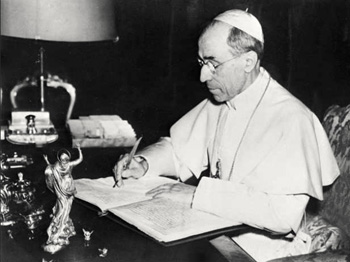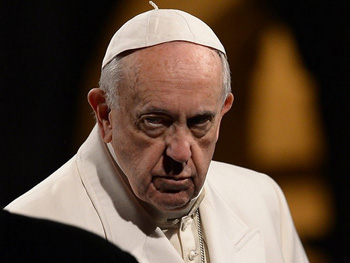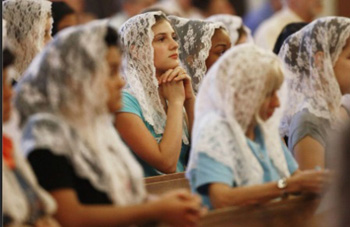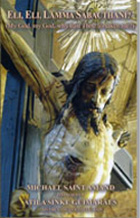Traditionalist Issues
 |
 |
 |
 |
 |
 |
 |
Dialogue Mass - CXXVIII
Pope Francis’s Hermeneutic of ‘Rigidity’
The preceding articles have provided abundant and irrefutable evidence that the accusation of “Clericalism” has become an ideological cause, onto which many of the progressivists’ prejudices against Tradition have been projected. Having started as a visceral objection to rule by clerics, the charge has itself become the ruling ideology in the Vatican II Church, one that has been initiated, nurtured and maintained by clerics.
 Chief among these was, of course, Fr. George Tyrrell, about whom his friend and protector, Maude Petre, stated that “many, many are the things openly said by Catholics, priests or laymen, that could never have been safely said had men like Tyrrell not first said them, and been decapitated for so doing.”(1) Now even Popes are saying what Tyrrell said, and it is traditionalists who have been decapitated.
Chief among these was, of course, Fr. George Tyrrell, about whom his friend and protector, Maude Petre, stated that “many, many are the things openly said by Catholics, priests or laymen, that could never have been safely said had men like Tyrrell not first said them, and been decapitated for so doing.”(1) Now even Popes are saying what Tyrrell said, and it is traditionalists who have been decapitated.
‘Rigidity’ & the ‘New Morality’
Of all the jeering slogans in Francis’s arsenal of insults against traditionalists, the accusation of “rigidity” is the weapon of choice most associated with his pontificate. Even a cursory glance through the Vatican website reveals that the word “rigidity,” like his many criticisms of the “Doctors of the Law,” is a recurring refrain of his speeches and writings – so much so that it has become associated with his name.
It may come as a surprise, therefore, to find that “rigidity” as a term of abuse launched by progressivists against Catholics who uphold Catholic Morals has a long history, stretching back to Fr. Tyrrell and the early Modernist Movement.
Pope Pius XII, in his 1952 Radio Message, alerted Catholic educators that promoters of what he termed the “New Morality” (otherwise known as Situation Ethics) were accusing the Church of preaching “almost exclusively and with excessive rigidity (excessiva rigidità), on the firmness and the intransigence of Christian moral laws … instead of fostering the law of human liberty and of love, and of insisting on it as a worthy dynamic of the moral life.” (2) The Pope reminded the faithful that “the accusation of oppressive rigidity made against the Church by the ‘new morality’ in reality attacks, in the first place, the adorable Person of Christ Himself.”(3)
In a speech later in the same year, (4) Pius XII considered it vital that all the faithful understand the Divine foundation on which Catholic Morality is established and the goal towards which it aims – the salvation of souls. In particular, he noted the prevailing trend among liberal Catholics to consider those who unbendingly try to follow the Law of God as being guilty of “l’hypocrisie d'une fidélité pharisaïque aux lois” (the hypocrisy of the Pharisees who meticulously observe the laws.)
It will be helpful to keep these points in mind when we come to examine some of the frequent occasions when the term “rigidity” has been used by Francis in the sense reprobated by Pius XII.
Francis, ‘rigidity’ & the ‘New Morality’
In the hands of Pope Francis, rigidity is a word that cannot be pinned down to a clear definition. Its elusiveness is precisely what makes it valuable as a propaganda term. It can mean whatever he wishes it to mean in whatever circumstances he chooses. Typically, he uses it to convey a sense of fury (cue Tyrrell) against Tradition. Here we will see how he uses it as a catch-all insult for just about everything that irks him about traditionalists.
 His brief is fixed and immutable, based on intolerance towards anyone who questioned the Vatican II reforms. In fact, one can hardly think of anything more rigid – or unmerciful – than his own implacable opposition to traditional Catholicism. He has now openly endorsed the eradication of Tradition altogether by ordering the world’s Bishops to limit the celebration of the traditional Latin Mass with a view to its extinction, and to forbid the use of pre-Vatican II Sacraments.
His brief is fixed and immutable, based on intolerance towards anyone who questioned the Vatican II reforms. In fact, one can hardly think of anything more rigid – or unmerciful – than his own implacable opposition to traditional Catholicism. He has now openly endorsed the eradication of Tradition altogether by ordering the world’s Bishops to limit the celebration of the traditional Latin Mass with a view to its extinction, and to forbid the use of pre-Vatican II Sacraments.
From this we gather that, for Pope Francis, not all “rigidities” are equal: Some, apparently, are more equal than others.
The unacceptable rigidities
When we examine the instances in which Francis uses the adjective “rigid” as a term of abuse, we cannot fail to notice that it is always directed against Catholics who refuse to abandon the Faith of their spiritual ancestors. There is no gainsaying the deep antipathy with which he views these faithful members of the Church: They are, in his eyes, to be condemned for the following “clericalist” crimes: The openly revolutionary and deeply philistine nature of this position is undeniable. It is in keeping with the proponents of “Cancel Culture” who love to shame the virtuous and promote immorality as normal. It is as if Francis were encouraging the faithful to love sin and hate what is good.
The openly revolutionary and deeply philistine nature of this position is undeniable. It is in keeping with the proponents of “Cancel Culture” who love to shame the virtuous and promote immorality as normal. It is as if Francis were encouraging the faithful to love sin and hate what is good.
In this article and the next, we will see how Pope Francis continues to show himself to be malevolently disposed towards those who try to uphold the doctrines and precepts taught by the Church. By persistently deviating from what has always been regarded as normal, Francis has brought about the perverse outcome that trouncing the Faith of all the Christian centuries is now identified with virtue. Indeed, anyone listening to his frequent attacks on “rigidity” could easily gain the impression that the road to Hell is paved with moral fervor.
Who are the intolerable ‘rigid types’ of whom Francis speaks?
The short answer is anyone who opposes his progressivist agenda. The longer one, fleshed out by Francis himself, homes in on the usual suspects – those who refuse to go along with the Revolution and display the following characteristics:
“Hostile inflexibility, that is, wanting to close oneself within the written word, (the letter) and not allowing oneself to be surprised by God, by the God of surprises, (the spirit); within the law, within the certitude of what we know and not of what we still need to learn and to achieve. From the time of Christ, it is the temptation of the zealous, of the scrupulous, of the solicitous and of the so-called – today – ‘traditionalists’ and also of the intellectuals.” (5)
From the beginning of his pontificate (the above words were written in 2014), Francis has been creating negative stereotypes about “rigid” Catholics, i.e., those who stand firm on principles that are non-negotiable. Here, he corrals them into a group so that they can be collectively tarred as extremist, closed-minded, hard-hearted, psychologically impaired and unable to keep up with the times. He confessed to wanting to throw a banana skin in front of them as a remedy for their alleged pride and “rigidity,” “so that they will take a good fall, and feel shame that they are sinners.”(6)
We can be sure that the banana skin joke was not meant in a good-natured way, for ever since then, Francis has been waging a relentless war against traditionalists; he has persistently stigmatized, marginalized and made access to the traditional rites difficult for them. In short, he has set the stage for the rejection and persecution of traditional Catholics.
No time for young ‘rigid’ traditionalists
Francis has expressed incredulity at the popularity of the traditional Latin Mass and Sacraments with the rising generation of young people today, over half a century since the imposition of the Novus Ordo Missae:
 “I ask myself about this. For example, I always try to understand what’s behind the people who are too young to have lived the pre-Conciliar liturgy but who want it. Sometimes I’ve found myself in front of people who are too strict, who have a rigid attitude. And I wonder: How come such rigidity? Dig, dig, this rigidity always hides something: insecurity, sometimes even more… Rigidity is defensive. True love is not rigid.” (7)
“I ask myself about this. For example, I always try to understand what’s behind the people who are too young to have lived the pre-Conciliar liturgy but who want it. Sometimes I’ve found myself in front of people who are too strict, who have a rigid attitude. And I wonder: How come such rigidity? Dig, dig, this rigidity always hides something: insecurity, sometimes even more… Rigidity is defensive. True love is not rigid.” (7)
Young people being attracted to the traditional Mass is a phenomenon which is hard to fathom by those who had confidently predicted the demise of the ancient rites and their replacement by what they term “vibrant,” creative liturgies thought to be more appealing to the youth. Not only was this aim delusional, but the evidence shows that a key feature of most celebrations of the New Mass is the dearth of young people in the congregation.
A pertinent point that suggests itself in Francis’s words is that he is not, after all, as close to the people as he claimed to be; otherwise he would have understood, and not harshly judged, the growing numbers of young people around the world who are attracted to the traditional Mass for its truth, goodness and beauty. This is not difficult to grasp if we consider the following axiomatic points.
On the one hand, heterodox theology and modern liturgy complement each other, and the combination of both encourages immoral behavior; while, on the other, orthodox theology is supported by traditional forms of worship and produces not only holiness but also plentiful vocations to the priesthood. Put simply – for those who may still be mystified – many young people today treasure their spiritual patrimony and wish to preserve it because it is the authentic expression of the Church’s age-old lex credendi, lex orandi and lex vivendi.
Continued


Maude Petre, a Catholic nun involved in the modernist controversy
‘Rigidity’ & the ‘New Morality’
Of all the jeering slogans in Francis’s arsenal of insults against traditionalists, the accusation of “rigidity” is the weapon of choice most associated with his pontificate. Even a cursory glance through the Vatican website reveals that the word “rigidity,” like his many criticisms of the “Doctors of the Law,” is a recurring refrain of his speeches and writings – so much so that it has become associated with his name.
It may come as a surprise, therefore, to find that “rigidity” as a term of abuse launched by progressivists against Catholics who uphold Catholic Morals has a long history, stretching back to Fr. Tyrrell and the early Modernist Movement.
Pope Pius XII, in his 1952 Radio Message, alerted Catholic educators that promoters of what he termed the “New Morality” (otherwise known as Situation Ethics) were accusing the Church of preaching “almost exclusively and with excessive rigidity (excessiva rigidità), on the firmness and the intransigence of Christian moral laws … instead of fostering the law of human liberty and of love, and of insisting on it as a worthy dynamic of the moral life.” (2) The Pope reminded the faithful that “the accusation of oppressive rigidity made against the Church by the ‘new morality’ in reality attacks, in the first place, the adorable Person of Christ Himself.”(3)
In a speech later in the same year, (4) Pius XII considered it vital that all the faithful understand the Divine foundation on which Catholic Morality is established and the goal towards which it aims – the salvation of souls. In particular, he noted the prevailing trend among liberal Catholics to consider those who unbendingly try to follow the Law of God as being guilty of “l’hypocrisie d'une fidélité pharisaïque aux lois” (the hypocrisy of the Pharisees who meticulously observe the laws.)
It will be helpful to keep these points in mind when we come to examine some of the frequent occasions when the term “rigidity” has been used by Francis in the sense reprobated by Pius XII.
Francis, ‘rigidity’ & the ‘New Morality’
In the hands of Pope Francis, rigidity is a word that cannot be pinned down to a clear definition. Its elusiveness is precisely what makes it valuable as a propaganda term. It can mean whatever he wishes it to mean in whatever circumstances he chooses. Typically, he uses it to convey a sense of fury (cue Tyrrell) against Tradition. Here we will see how he uses it as a catch-all insult for just about everything that irks him about traditionalists.

Pius XII condemned the New Morality
From this we gather that, for Pope Francis, not all “rigidities” are equal: Some, apparently, are more equal than others.
The unacceptable rigidities
When we examine the instances in which Francis uses the adjective “rigid” as a term of abuse, we cannot fail to notice that it is always directed against Catholics who refuse to abandon the Faith of their spiritual ancestors. There is no gainsaying the deep antipathy with which he views these faithful members of the Church: They are, in his eyes, to be condemned for the following “clericalist” crimes:
- Clinging to Tradition for “security”;
- Standing firm on principles that are non-negotiable;
- Upholding the Sixth Commandment;
- Uncompromisingly defending the Faith;
- Maintaining high standards of discipline in seminaries;
- Wearing the cassock and certain items of ecclesiastical headgear.

For Francis it is fine to be rigid against what he calls ‘the rigid traditionalists’ – a curious concept of justice
In this article and the next, we will see how Pope Francis continues to show himself to be malevolently disposed towards those who try to uphold the doctrines and precepts taught by the Church. By persistently deviating from what has always been regarded as normal, Francis has brought about the perverse outcome that trouncing the Faith of all the Christian centuries is now identified with virtue. Indeed, anyone listening to his frequent attacks on “rigidity” could easily gain the impression that the road to Hell is paved with moral fervor.
Who are the intolerable ‘rigid types’ of whom Francis speaks?
The short answer is anyone who opposes his progressivist agenda. The longer one, fleshed out by Francis himself, homes in on the usual suspects – those who refuse to go along with the Revolution and display the following characteristics:
“Hostile inflexibility, that is, wanting to close oneself within the written word, (the letter) and not allowing oneself to be surprised by God, by the God of surprises, (the spirit); within the law, within the certitude of what we know and not of what we still need to learn and to achieve. From the time of Christ, it is the temptation of the zealous, of the scrupulous, of the solicitous and of the so-called – today – ‘traditionalists’ and also of the intellectuals.” (5)
From the beginning of his pontificate (the above words were written in 2014), Francis has been creating negative stereotypes about “rigid” Catholics, i.e., those who stand firm on principles that are non-negotiable. Here, he corrals them into a group so that they can be collectively tarred as extremist, closed-minded, hard-hearted, psychologically impaired and unable to keep up with the times. He confessed to wanting to throw a banana skin in front of them as a remedy for their alleged pride and “rigidity,” “so that they will take a good fall, and feel shame that they are sinners.”(6)
We can be sure that the banana skin joke was not meant in a good-natured way, for ever since then, Francis has been waging a relentless war against traditionalists; he has persistently stigmatized, marginalized and made access to the traditional rites difficult for them. In short, he has set the stage for the rejection and persecution of traditional Catholics.
No time for young ‘rigid’ traditionalists
Francis has expressed incredulity at the popularity of the traditional Latin Mass and Sacraments with the rising generation of young people today, over half a century since the imposition of the Novus Ordo Missae:

The progressivists ignore the great attraction the youth have for the Traditional Mass
Young people being attracted to the traditional Mass is a phenomenon which is hard to fathom by those who had confidently predicted the demise of the ancient rites and their replacement by what they term “vibrant,” creative liturgies thought to be more appealing to the youth. Not only was this aim delusional, but the evidence shows that a key feature of most celebrations of the New Mass is the dearth of young people in the congregation.
A pertinent point that suggests itself in Francis’s words is that he is not, after all, as close to the people as he claimed to be; otherwise he would have understood, and not harshly judged, the growing numbers of young people around the world who are attracted to the traditional Mass for its truth, goodness and beauty. This is not difficult to grasp if we consider the following axiomatic points.
On the one hand, heterodox theology and modern liturgy complement each other, and the combination of both encourages immoral behavior; while, on the other, orthodox theology is supported by traditional forms of worship and produces not only holiness but also plentiful vocations to the priesthood. Put simply – for those who may still be mystified – many young people today treasure their spiritual patrimony and wish to preserve it because it is the authentic expression of the Church’s age-old lex credendi, lex orandi and lex vivendi.
Continued
- Maude Petre, My Way of Faith, London: J.M. Dent and Sons, 1937, p. 208.
- Pius XII, “De Conscientia Christiana in Iuvenibus Recte Efformanda” (On the correct formation of a Christian conscience in young people), Radio Message on the Occasion of ‘Family Day,’ March 23, 1952, AAS, 44, 1952, p. 274.
- Ibid., p. 275.
- “Discours du Pape Pie XII aux Participants au Congrès de la Fédération Mondiale des Jeunesses Féminines Catholiques” (Address of Pope Pius XII to the Congress of the World Federation of Young Catholic Women), April 18, 1952, AAS 44, 1952, p. 416.
- Francis, Address at the conclusion of the Extraordinary Synod on the Family, October 18, 2014.
- Francis, “Rigidity is a sign of a weak heart,” Vatican Radio Archive, The Voice of the Pope and the Church in Dialogue with the World, December 15, 2014.
- Francis, Interview with Fr Antonio Spadaro, SJ, November 18, 2016.
Posted July 26, 2023

______________________
______________________
 Volume I |
 Volume II |
 Volume III |
 Volume IV |
 Volume V |
 Volume VI |
 Volume VII |
 Volume VIII |
 Volume IX |
 Volume X |
 Volume XI |
 Special Edition |


